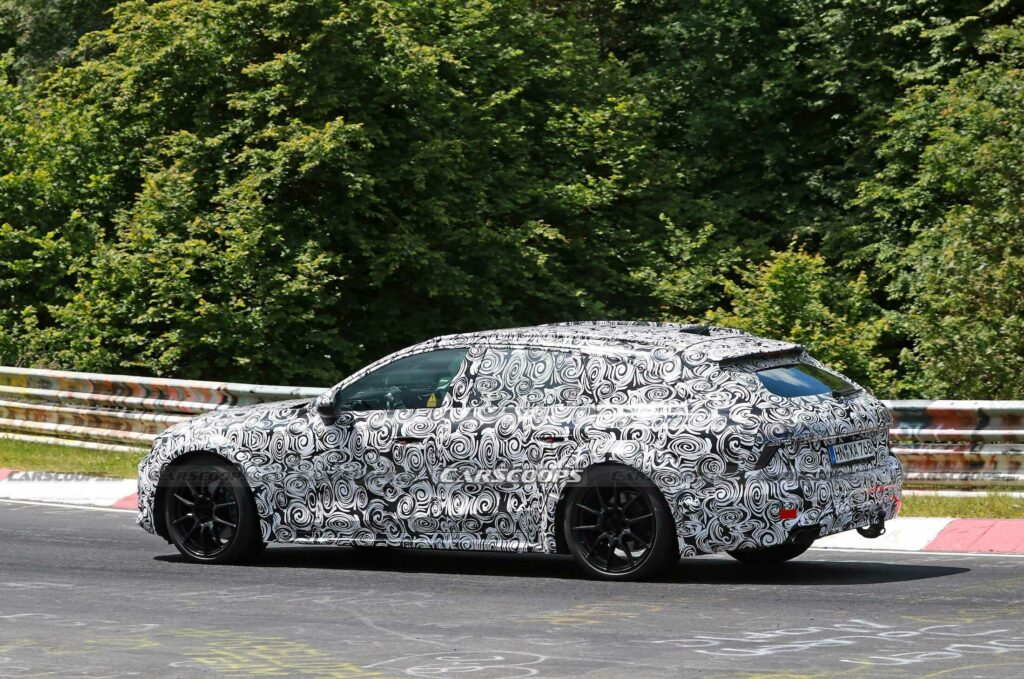
- Audi RS7 Avant prototype spied testing ahead of 2025 launch.
- Model takes over from RS6, whose badge will be used on a rapid EV.
- This car displays no charging flap, but a 700+ hp plug-in V8 seems the most likely power source.
BMW fans eagerly await the return of the M5 Touring – and its first official posting to America, but Audi enthusiasts have just as much to look forward to, as these images of the 2026 RS7 Avant show.
var adpushup = window.adpushup = window.adpushup || {que:[]};
adpushup.que.push(function() {
if (adpushup.config.platform !== “DESKTOP”){
adpushup.triggerAd(“4d84e4c9-9937-4f84-82c0-c94544ee6f2a”);
}
else{
adpushup.triggerAd(“6a782b01-facb-45f3-a88f-ddf1b1f97657”);
} });
The RS7 Avant sounds like a new model, but it’s only the name that’s new. In essence, the wide-track wagon is the replacement for the current RS6 Avant, but next time around the RS6 will be an EV because Audi is shifting all of its electric cars to even numbers and giving combustion models the odd ones. So the RS7, which is currently a single model, a four-door fastback coupe version of the RS6, becomes a family of two: the RS7 Sportback and the RS7 Avant.
Related: Audi’s RS7 Mule Gearing Up To Test Its PHEV Powertrain On The Ring
Though the flared fenders on this test car don’t appear to be the finished items, they do at least give us an idea of the track width, confirming that the halo model will be substantially wider than both the regular A7 we spotted last month, and the mildly-spiced S7, which will also be available in both liftback sedan and wagon forms in Europe, but probably only as sedans in the US.
window._taboola = window._taboola || [];
_taboola.push({
mode: ‘thumbnails-a-mid’,
container: ‘taboola-mid-article’,
placement: ‘Mid Article’,
target_type: ‘mix’
});
window._taboola = window._taboola || [];
_taboola.push({
mode: ‘thumbnails-oc-2×1’,
container: ‘taboola-mid-article-thumbnails-organic’,
placement: ‘Mid Article Thumbnails Organic’,
target_type: ‘mix’
});
The strangely Hyundai-esque grille pattern on the nose, big brakes and the small inverted LED dorsal fins beneath each rear light cluster look like production items, but this early prototype still lacks the the pair of wide oval-shaped exhaust tailpipes Audi fans will expect the finished car to feature.

This car also throws up questions about what kind of powertrain the pipes are hooked up to. It doesn’t have a charging flap or any hybrid safety stickers, suggesting it might simply use the current RS6’s 4.0-liter bi-turbo V8, tuned to deliver a big extra helping of horses over the current car’s 621 hp (630 PS).
But far more likely is that the final production car will get a plug-in version of that same V8, a recipe used by Porsche to great effect in cars like the Cayenne and Panamera, and more recently adopted by both Lamborghini for the 789 hp (800 PS) Urus SE and Bentley, in the 771 hp (782 PS) Continental GT.
var adpushup = window.adpushup = window.adpushup || {que:[]};
adpushup.que.push(function() {
if (adpushup.config.platform !== “DESKTOP”){
adpushup.triggerAd(“5646c171-cb6e-4e2c-8440-49013ca72758”);
}
else{
adpushup.triggerAd(“e7c4c913-3924-4b2d-9279-6c00984dd130”);
} });
